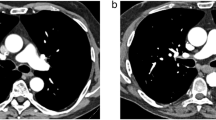Abstract
Objective
It has been shown that [18F]-fluorodeoxyglucose positron emission tomography/computed tomography (FDG-PET/CT) can identify macrophage-rich high-risk atherosclerotic plaques in animal models as well as in patients with atherosclerotic plaques in the carotid arteries. The development of inflamed macrophage-rich plaques over time is not well known. This study was performed to determine the variability of such FDG-accumulating plaques between consecutive PET/CT examinations.
Methods
Twenty-eight patients who underwent two whole-body FDG-PET/CT examinations within 7 months for malignant diseases were re-evaluated for atherosclerotic lesions in major arterial segments. The plaques were identified as active, inactive, or mixed depending on their appearance on PET and CT. Every identified plaque was compared with that of the other examination to evaluate the time-to-time correlation.
Results
The time-to-time correlation was close to 100% for calcified inactive plaques and about 50% for FDG-accumulating active plaques, with a high consistency between all examined arterial segments in this material.
Conclusions
A large proportion of FDG-accumulating plaques can be identified on consecutive FDG-PET/CT examinations within 7 months.
Similar content being viewed by others
References
Libby P. Inflammation in atherosclerosis (review). Nature 2002;420:868–874.
Kapoor V, McCook BM, Torok FS. An introduction to PETCT imaging. Radiographics 2004;24:523–543.
Bleeker-Rovers CP, Bredie SJ, van der Meer JW, Corstens 0FH, Oyen WJ. F-18-fluorodeoxyglucose positron emission tomography in diagnosis and follow-up of patients with different types of vasculitis. Neth J Med 2003;61:323–329.
Blockmans D, De Ceuninck L, Vanderschueren S, Knockaert D, Mortelmans L, Bobbaers H. Repetitive 18-fluorodeoxyglucose positron emission tomography in isolated polymyalgia rheumatica: a prospective study in 35 patients. Rheumatology (Oxford) 2007;46:672–677.
Lederman RJ, Raylman RR, Fisher SJ, Kison PV, San H, Nabel EG, et al. Detection of atherosclerosis using a novel positron-sensitive probe and 18-fluorodeoxyglucose (FDG). Nucl Med Commun 2001;22:747–753.
Ogawa M, Ishino S, Mukai T, Asano D, Teramoto N, Watabe H, et al. (18)F-FDG accumulation in atherosclerotic plaques: immunohistochemical and PET imaging study. J Nucl Med 2004;45:1245–1250.
Rudd JH, Warburton EA, Fryer TD, Jones HA, Clark JC, Antoun N, et al. Imaging atherosclerotic plaque inflammation with [18F]-fluorodeoxyglucose positron emission tomography. Circulation 2002;105:2708–2711.
Davies JR, Rudd JH, Fryer TD, Graves MJ, Clark JC, Kirkpatrick PJ, et al. Identification of culprit lesions after transient ischemic attack by combined 18F fluorodeoxyglucose positron-emission tomography and high-resolution magnetic resonance imaging. Stroke 2005;36:2642–2647.
Tawakol A, Migrino RQ, Bashian GG, Bedri S, Vermylen D, Cury RC, et al. In vivo 18F-fluorodeoxyglucose positron emission tomography imaging provides a noninvasive measure of carotid plaque inflammation in patients. J Am Coll Cardiol 2006;48:1818–1824.
Tahara N, Kai H, Ishibashi M, Nakaura H, Kaida H, Baba K, et al. Simvastatin attenuates plaque inflammation: evaluation by fluorodeoxyglucose positron emission tomography. J Am Coll Cardiol 2006;48:1825–1831.
Ben-Haim S, Kupzov E, Tamir A, Frenkel A, Israel O. Changing patterns of abnormal vascular wall F-18 fluorodeoxyglucose uptake on follow-up PET/CT studies. J Nucl Cardiol 2006;13:791–800.
Rudd JH, Myers KS, Bansilal S, Machac J, Rafique A, Farkouh M, et al. (18)Fluorodeoxyglucose positron emission tomography imaging of atherosclerotic plaque inflammation is highly reproducible: implications for atherosclerosis therapy trials. J Am Coll Cardiol 2007;50:892–896.
Ben-Haim S, Kupzov E, Tamir A, Israel O. Evaluation of 18F-FDG uptake and arterial wall calcifications using 18F-FDG PET/CT. J Nucl Med 2004;45:1816–1821.
Dunphy MP, Freiman A, Larson SM, Strauss HW. Association of vascular 18F-FDG uptake with vascular calcification. J Nucl Med 2005;46:1278–1284.
Author information
Authors and Affiliations
Corresponding author
Rights and permissions
About this article
Cite this article
Wassélius, J., Larsson, S. & Jacobsson, H. Time-to-time correlation of high-risk atherosclerotic lesions identified with [18F]-FDG-PET/CT. Ann Nucl Med 23, 59–64 (2009). https://doi.org/10.1007/s12149-008-0207-3
Received:
Accepted:
Published:
Issue Date:
DOI: https://doi.org/10.1007/s12149-008-0207-3




